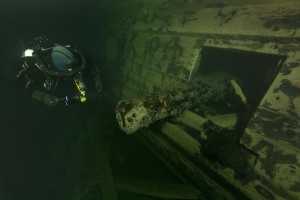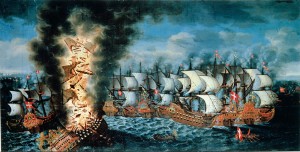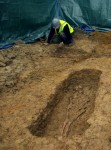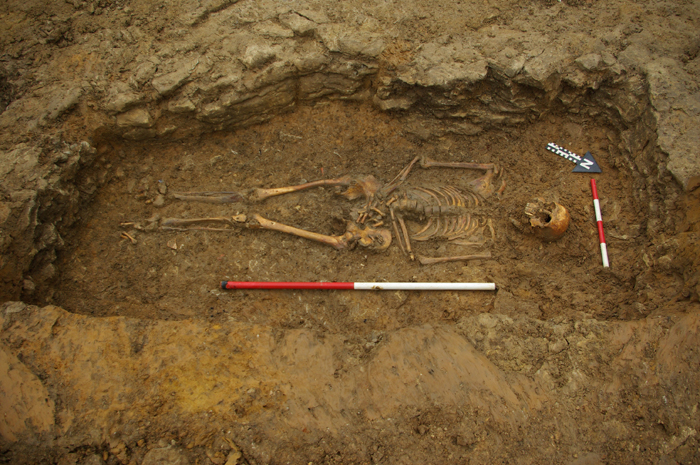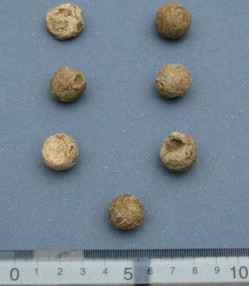Scientific American has recently digitized its archives, every issue of the magazine from the first one in August 28, 1845 to the most recent. Most of them can only be accessed by subscribers to the print edition, educational institutions with a site license or on a pay-per-view basis. There’s brief window during which those of us of a historico-nerdly bent can wallow as deeply as we please in all of the oldest issues free of charge. Until November 30, all of the Scientific American issues published between 1845 and 1909 will be available for free.
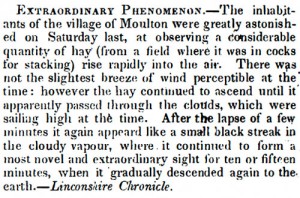 Each issue has a table of contents of individual articles that you can read or you can download the entire issue in a single pdf, which is what I’ve been doing because the cover and the advertisements are just as cool as the articles. SciAm’s Anecdotes from the Archives blog has an interesting entry on the first issue, which was tailored to appeal to people from many walks of life, not just scientists and inventors. There were book reviews, poems, even what appear to be News of the World-style tall tales categorized as “interesting news of passing events.”
Each issue has a table of contents of individual articles that you can read or you can download the entire issue in a single pdf, which is what I’ve been doing because the cover and the advertisements are just as cool as the articles. SciAm’s Anecdotes from the Archives blog has an interesting entry on the first issue, which was tailored to appeal to people from many walks of life, not just scientists and inventors. There were book reviews, poems, even what appear to be News of the World-style tall tales categorized as “interesting news of passing events.”
In the three 1845 issues I’ve read thus far, new patents take a prominent position both in column-inches and in advertising. Little wonder, because the mid-19th century was a boom time for patents and new inventions. Patent models were exhibited in galleries and gazed upon like Old Master art.
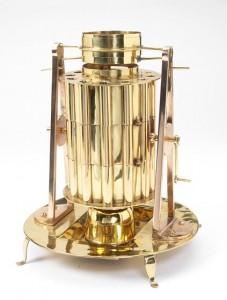 Those days are upon us again, albeit in far reduced form, thanks to an exhibit of patent models at the Smithsonian that just opened on November 11. Inventing a Better Mousetrap: Patent Models from the Rothschild Collection will be at the Smithsonian American Art Museum until November 3, 2013. That’s the perfect location seeing as the building that now houses the American Art Museum (and the National Portrait Gallery) was authorized by President Andrew Jackson in the Patent Act of 1836, to serve as a fireproof patent office.
Those days are upon us again, albeit in far reduced form, thanks to an exhibit of patent models at the Smithsonian that just opened on November 11. Inventing a Better Mousetrap: Patent Models from the Rothschild Collection will be at the Smithsonian American Art Museum until November 3, 2013. That’s the perfect location seeing as the building that now houses the American Art Museum (and the National Portrait Gallery) was authorized by President Andrew Jackson in the Patent Act of 1836, to serve as a fireproof patent office.
Jackson signed the bill on the Fourth of July. On December 15, 1836, while the new fireproof building was still in the early stages of construction, a fire broke out at Blodgett’s Hotel where the Patent Office shared space with the General Post Office and Washington City Post Office. Although there was a fire station right next door to guard against just such an eventuality, the engines had been equipped in 1820. The leather hose fell apart in the firefighters’ hands and the pump never even started. The Patent Office, the only building that the British left alone during the Burning of Washington in 1814 thanks solely to the intervention Dr. William Thornton, architect of the United States Capitol, inventor, physician and first Superintendent of the Patent Office, who convinced the British command to spare the Patent Office because of its importance to mankind, burned with all its contents.
All the patents and patent models kept since the creation of the office as per the U.S. Constitution (Article I, Section 8) and the Patent Act of 1790 were destroyed. The only patent records left were in a book that had been removed from the premises against Patent Office rules by a draftsman named William Steiger and whatever was in the memory of the sole patent examiner. That’s 10,000 patents, most of them lost irretrievably. There was an attempt to put the archive back together using private files and reproductions of the models. The Patent Office wrote to every inventor it could think of asking them to recreate models and paperwork. In the end, they were able to restore 2,845 of the 10,000 lost, all of them reissued with a patent number beginning with “X.” The patent numbers began again with “1” starting with ones issued in July because all of the most recent patents had been easily recovered from the inventors’ records.
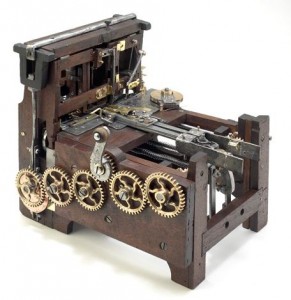 Once safely ensconced in the new building, the patent models were put on public display. Admission was free and with the explosion of industrialization in the mid-19th century, inventions and mechanical models drew big crowds. Approximately 100,000 people a year visited the Patent Office in the 1850s to view the models held in three tiers of nine-foot-high display cases. In 1880, the Patent Office stopped requiring inventors to submit a model. It had accumulated 200,000 patent models by that date.
Once safely ensconced in the new building, the patent models were put on public display. Admission was free and with the explosion of industrialization in the mid-19th century, inventions and mechanical models drew big crowds. Approximately 100,000 people a year visited the Patent Office in the 1850s to view the models held in three tiers of nine-foot-high display cases. In 1880, the Patent Office stopped requiring inventors to submit a model. It had accumulated 200,000 patent models by that date.
At the turn of the century, as the Department of the Interior grew and expanded into the Patent Office’s space, the models were removed from display and put in storage. Then, in 1924, Congress, which had once passed laws to help the Patent Office recover the records lost in the Great Fire, suddenly became concerned about the exorbitant cost of storing these “useless” models. It allocated $10,000 to get rid of that immense collection of the history of American ingenuity, mechanical science, industry, play, posthaste. The families of the inventors claimed some. Whatever museum asked for any got them (the Smithsonian claimed 2,500). The rest were all sold at auction in 1925.
Sir Henry Wellcome, founder of Wellcome Pharmaceutical Company (now Glaxo Smith Kline) and London’s splendid Wellcome Collection of medical artifacts and curiosities, purchased the entirety of the United States Patent Office’s models at the auction. He intended to build a museum of the patent model, but the Wall Street Crash of 1929 stopped him in his tracks. After his death in 1936, the trustees of Wellcome’s estate sold the patent models to a Broadway producer for $50,000. He sold it for $75,000 to a group of businessmen who also planned to build a museum, but they were forced to file for bankruptcy in 1941 and the models were sold to, of all people, an auctioneer named O. Rundle Gilbert for the measly sum of $5,000. Needless to say, after that, the models were sold to collectors far and wide.
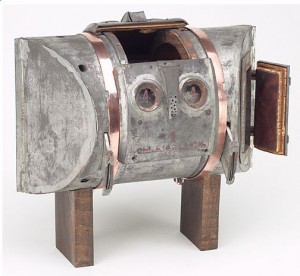 It wasn’t until the 1970s that aerospace engineer Cliff Petersen bought all the crates Gilbert had left, 800 of them still in their 1926 packaging, and donated 30,000 of the models within to the United States Patent Model Foundation. He kept about 5,000 models for his personal collection.
It wasn’t until the 1970s that aerospace engineer Cliff Petersen bought all the crates Gilbert had left, 800 of them still in their 1926 packaging, and donated 30,000 of the models within to the United States Patent Model Foundation. He kept about 5,000 models for his personal collection.
Alan Rothschild, an inventor in his own right and model collector, bought the bulk of Petersen’s collection in the 1990s. He opened the Rothschild Petersen Patent Model Museum in 1998 to house the almost 4,000 patent models in his collection. Space at the museum is very limited, so the models are not on public display but only viewable upon appointment. They are regularly loaned to other institutions, however, and some are part of a travelling tour called The Curious World of Patent Models currently winding its way through the United States. You can find dates where the exhibit will be at a museum near you on this page.
Thirty-two of the models in the Rothschild Collection are part of the Smithsonian exhibit. Alan Rothschild himself will be at the American Art Museum for a lecture on December 1, 2011, 7–8 PM, along with curator Charles Robertson to discuss the patent models on display, their inventors and the period. Admission is free.
You can search the Rothschild Petersen Patent Model Museum’s collection online. They have an extensive database with featured items of interest as well as links to the original patent applications complete with explanations and drawings. The Smithsonian exhibit has a small but sweet picture slideshow here.




